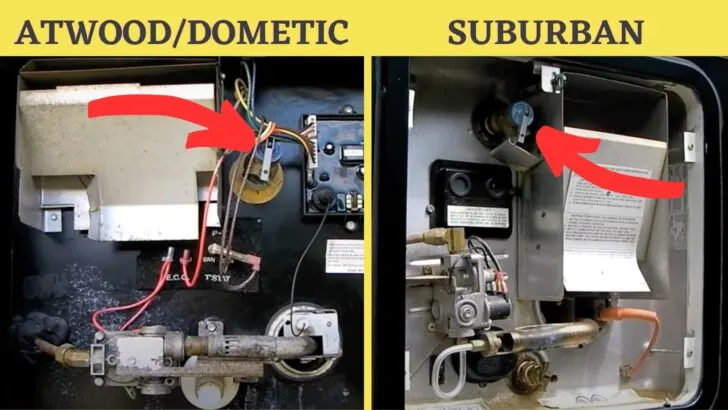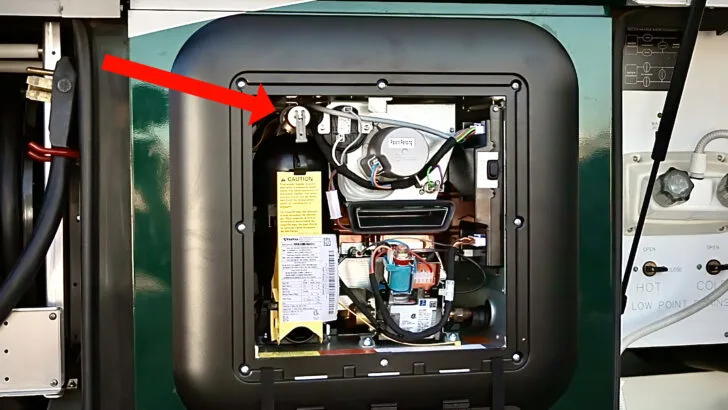We’ve covered RV water heaters from a few different angles here on the blog before. But today we’re talking specifically about the water heater pressure relief valve.
It may seem unimportant — a thing you flip when you’re draining your water heater for annual maintenance or winterization.
But that little valve is actually an important safety feature.
We’ll get into what an RV water heater pressure relief valve is, what it does, and why it’s so important. We’ll also tell you what to do if you find that yours is leaking, and how to replace it if necessary.
- 1) What Is an RV Water Heater Pressure Relief Valve?
- 2) Where Is My RV’s Pressure Relief Valve?
- 3) How Does an RV Water Heater Pressure Relief Valve Work?
- 4) What Should I Do If My Water Heater Pressure Relief Valve Is Leaking?
- 5) How to Replace an RV Water Heater Pressure Relief Valve
- 6) Free RVing Tips, Tricks, Reviews, Giveaways & More
What Is an RV Water Heater Pressure Relief Valve?
A water heater pressure relief valve is a safety mechanism found not only on your RV’s water heater but also on home water heaters.
These valves are also referred to as T&P valves (or TPR valves) because they measure both water pressure and temperature (which is typically between 120 and 140 degrees.) The valve provides relief if either gets too high.
Water heater pressure relief valves exist to keep you safe because if the pressure were to get too high, the water heater tank could crack or burst. A metal tank could actually explode.
That’s why the valve is so important.
Where Is My RV’s Pressure Relief Valve?
Your RV likely has either an Atwood/Dometic water heater or a Suburban water heater, since they’re the most common brands.
The pressure relief valve looks the same on each brand of water heater, and is located near the top of the unit.

These are the locations of the pressure relief valves on Atwood/Dometic and Suburban RV water heaters

The location of the pressure relief valve on our new (and awesome) Truma AquaGo Comfort on-demand RV water heater.
How Does an RV Water Heater Pressure Relief Valve Work?
As we mentioned above, the purpose of the value is to let off excess pressure and temperature if either gets too high.
Note that your RV’s water heater is a closed system. As a result, thermal expansion occurs within the tank because water expands when it’s heated.
For example, if you’ve got a 20-gallon RV water heater, then when water is heated to the setting on your thermostat, it will expand by nearly 1/4 gallon. This extra volume has to go somewhere, otherwise pressure will continue to increase to dangerous levels.
When the temperature of the water in the tank is between 120-140 degrees, both the tank and the water expand. This is the process of thermal expansion and is normal and expected.
But if the temperature of the water or the pressure in the tank were to rise to a dangerous level, (150 PSI/210° Fahrenheit), this is when a properly functioning water pressure relief valve springs into action.
In response to the excess heat and/or pressure, the pressure relief valve will open, releasing hot water and steam. (On an RV water heater, the release will happen right at the valve itself. A home hot water heater will have a discharge tube from which the excess water will drain.)
This will bring the pressure and temperature inside your water heater down to a safe level.
If you’re interested in learning more about thermal expansion and the function of a water heater’s pressure relief valve, you can check out this video from AMRE Supply:
What Should I Do If My Water Heater Pressure Relief Valve Is Leaking?
In our post on what to do if your RV water heater’s leaking, we have a brief section on what to do about a leaking pressure relief valve.
If the valve is weeping (dripping noticeably), the first thing you’ll want to do is to try re-establishing the air gap at the top of the tank. The gap helps provide a buffer for the pressure changes that occur in the tank from the heating and cooling cycles.
To do this, we suggest taking the following steps:
- Turn off the water heater and let it completely cool. (You’ll be releasing water from the water heater and you don’t want to risk getting scalded.)
- Turn off the water supply (both city water and your onboard pump).
- Open a faucet in the RV on full hot. (The water should quickly slow down to a dribble and then stop. If this doesn’t happen, you forgot step #2.)
- Remove the cover from the water heater.
- Lift the toggle valve on the pressure relief valve until it stands straight out in the fully open position. (Stand to the side when you do this — the contents may be under pressure which could spray you with water.)
- Allow the water to drain out until it stops.
- Close the pressure relief valve. (Let it snap shut to ensure it seals completely.)
- Close the inside faucet.
- Turn on the water supply and allow the system to repressurize.
(Note that you may have to repeat this process a couple of times, but usually just once fixes the issue.)
If this process doesn’t solve the weeping issue, then you may need to replace the pressure relief valve.
How to Replace an RV Water Heater Pressure Relief Valve
In order to replace the valve on your RV’s water heater, you’ll want to have a couple of items on hand.
While not absolutely required, a valve removal tool makes the job easier.
This is a universal tool that should work on either your Suburban or Atwood RV water heater:
- Fits most water heaters
- Remove and replace temperature and pressure valves safely and quickly
Of course, you’ll also need a replacement automatic temperature pressure relief valve.
Most RV water heaters probably have a 3/4″ valve, but some may have a 1/2″ valve. If you’re not sure which one you’ve got, check your valve or your owner’s manual to confirm the correct size for your water heater. Here are links to both sizes:
- Provides Protection: Helps protect your RV or home water heater from excess temperature and water pressure
- Connection: ¾-inch NPT connection allows hookup to RV and home water heaters; Dimensions: 1 3/16-inch shank; 4-inch probe
- Protects water heaters from excessive water temperatures and pressure
- Resistant to corrosion
For a tutorial on how to replace your RV’s water heater pressure relief valve, check out this video:
Free RVing Tips, Tricks, Reviews, Giveaways & More
Subscribe to our daily newsletter! We’ve been full-time RVers for 20 years (!) and share everything we’ve learned about RVing in our daily blog posts. Join our online community to receive a wealth of great RVing knowledge delivered right to your inbox.
Whether this is your first time on the road or you’re a seasoned full-timer, you’ll love the wide range of RVing topics we cover. Don’t miss a single article or any of our famous RV gear Giveaways — Subscribe today!





geynna Buffington
Tuesday 28th of February 2023
Does releasing pressure apply to tankless water heaters?
TheRVgeeks
Tuesday 28th of February 2023
Hi Geynna... the tankless water heaters we've seen (including our Truma AquaGo) still have pressure relief valves (there's a picture of our AquaGo's valve in the post).